This one is not visible on the main page yet, but I thought I'd share it here first:
Digital Exposure Techniques
It gives an overview of the pros/cons of the (1) "expose to the right" (ETTR) technique, (2) slight underexposure (to protect highlights) and (3) just using a standard exposure. Topics such as highlight clipping, tonal levels and shadow noise are all discussed.
As usual, please let me know if you feel anything is unclear, if you notice any typos or just want to add something from your own experience.
Thanks!
 Helpful Posts: 0
Helpful Posts: 0
Results 1 to 20 of 20
-
18th October 2010, 07:24 PM #1Administrator

- Join Date
- Apr 2008
- Location
- California, USA
- Posts
- 1,473
- Real Name
- Sean
New Article: Digital Exposure Techniques
-
18th October 2010, 09:03 PM #2
Re: New Tutorial: Digital Exposure Techniques
Great explanation!
Thanks you!
-
18th October 2010, 09:11 PM #3
-
19th October 2010, 12:03 AM #4
-
19th October 2010, 01:03 AM #5
Re: New Tutorial: Digital Exposure Techniques
Thanks Sean, extremely informative.
-
19th October 2010, 06:37 AM #6
Re: New Tutorial: Digital Exposure Techniques
Sean - Another well explained tutorial. I generally go along with what the others have said, but I do have a (major?) proviso. Up until the Conclusions, I had followed the theme, learnt a few things, and agreed where I had my own knowledge. However, the immediate conclusion that I would have drawn was that the exposure strategy to be adopted depends on the circumstances. That might need to be stated as the first point under conclusions. If that's true, then the rest of the conclusions read more coherently. One other point is that the word "special" referring to different circumstances is used several times. Words like "particular", "relevant", "appropriate" may be better as the word "special" does imply "special" and I'm not sure that is what you mean. (You perhaps appreciate my pedantic, academic and analytical background here
 )
)
Overall, the Conclusions might run:- Different strategies required in different circumstances;
Slight underexposure to be preferred in many even most circumstances;
ETTR the better approach if wide dynamic range etc;
standard exposure ....and so on.
Anyway, just some thoughts.
Cheers
David
-
20th October 2010, 02:24 PM #7

- Join Date
- Oct 2009
- Location
- Maryland, USA
- Posts
- 1,015
- Real Name
- Rick
Re: New Tutorial: Digital Exposure Techniques
Hi, Sean;
A great tutorial, with your usual excellent focus on the key points.
I do have a few comments, especially in agreement with Dave's point about wrapping the conclusion.
The very first sentence, I might suggest that the debate isn't characterized by what's correct, but rather by what's best. I don't know if what's "correct" is a reasonable goal. I really like your general concept of describing the whole thing as a "strategy," BTW. It helps clarify that it's a way to approach the problem.
Second section, "Unique Characteristics of Digital Photos," I'm not sure "Unique" is the best term. Film also fails to record above a certain intensity, so that isn't unique to digital. Aren't these characteristics to be balanced? I'd suggest the heading just be "Characteristics of Digital Photos," and the sentence that begins, "The key to knowing...," maybe end with "these (potentially) competing characteristics."
In the Conclusions, the paragraph that begins, "If you cannot risk an unusable photo, erring on the side of slight under-exposure is probably best." The initial sentence doesn't quite fit the paragraph, because it draws a box of conditions around when under-exposure is the best bet. I think this is where Dave's concept of noting that under-exposure is a broadly applicable general strategy would fit well.
Cheers,
Rick
-
20th October 2010, 10:05 PM #8Administrator

- Join Date
- Apr 2008
- Location
- California, USA
- Posts
- 1,473
- Real Name
- Sean
Re: New Tutorial: Digital Exposure Techniques
Rick & David: Thanks for the excellent feedback! You're right -- the conclusions really needs to incorporate a recap of what had been laid out in the introduction. I've just reworked the conclusions to place more emphasis on these key points ("different strategies required in different circumstances", etc). I might change this further after giving it another pass later on, but I think it's already a big improvement.
@Rick: With regards to the use of "unique," I would contend that all three characteristics are very different from film. Perhaps not 100% different, but different nonetheless. Yes, you can clip highlights with film, but this is rarely as abrupt unless you're using something like slide film. With image noise, film has the most visible grain in the highlights (the opposite of digital), which changes the mentality a lot. However, this is really besides the point because I still agree with your conclusion of just dropping the use of "unique" in the header . It's also just cleaner that way.
. It's also just cleaner that way.
Most of the other suggestions have now been incorporated as well in one way or another...Last edited by McQ; 21st October 2010 at 12:07 AM.
-
21st October 2010, 09:31 AM #9

- Join Date
- Jun 2008
- Location
- Bern, Switzerland
- Posts
- 41
- Real Name
- Reto
Re: New Tutorial: Digital Exposure Techniques
Let me first join the chorus: I always jump on any new piece of tutorial in CC. Thanks for this one, too.
I don't see the slight under-exposure as a strategy per se in digital photography, as it could be in analogue times for stylistic reasons (low key, contrast enhancement by longer development etc.). In my view, the slight under-exposure is a kind of correction to the excesses of ETTR. In other words, I would slightly underexpose a shot calibrated on ETTR to make sure the highlights are 'in', but certainly not a shot calibrated on the 'standard exposure' strategy. By the way, I would perhaps call the latter 'right exposure of middle tones' or something like that ('expose to the middle', expose for the mid-tones ?), since any strategy can be handled as a standard. ETTR is actually a kind of standard.
The histograms you refer to are the in camera JPEG histograms and the histograms a raw developer shows for 'standard' development (usually copied on the standard the camera maker uses for its JPEGs. I use them a lot but am not endless happy with them. The development curve is usually one, which produces brilliant pictures of brightly lit subjects, where most of the light is reflected. Contrast and saturation of the mid range are obtained by applying a rather steep density curve with a narrow 'shoulder' which swallows (sorry: compresses) 1 or 2 EV of data. If you switch the curve off (which is possible in the raw developers I use), I am able to get more differentiation in those tones, with the result that I get also a new histogram. The latter tells me more about what I have really captured.
What happens with the enhanced dynamic range of the new cameras? I have switched form an Olympus e-510 to a Canon 5DII, partly to benefit from the extended dynamic range. Well... The raw development programs compressed 1 EV of data on Olympus pictures into the shoulder, compress now 2 EV on Canon pictures... Where is the extension of the DR gone, if I stay with the standard development?
Needless to say, I rarely stay with the default raw development and often disable the 'foot and shoulder' curve. Then I see what the sensor has really (?)delivered and can start building my own development curve, applying the necessary corrections to contrast by enhancing the local contrast and sometimes the saturation. Of course, the decision, where to cut off (clip) the highlights is still pretty difficult with histogram curves which end in a very tiny but long tail.
Often, a picture I have exposed correctly to the near right according to the in camera histogram ends up to be pretty under exposed when linearized in the raw developer. Linearizing also saves some over-exposed pictures, bringing extreme values into the colorful range.
I would find it very useful if you thought about an extension to the discussed tutorial, which would handle the possibilities and problems related to the extended dynamic range of newer cameras. I totally support the idea to put the strategy of the photographer at in the center. Strategy depends depending on the technology at hand, the shooting situation and the 'rendering intent' (meant as anticipated result). The capacities of monitors and printers (incl. paper and inks) play a (limiting), certainly, but also our (culturally defined) way of looking at pictures. This was also the background of my questioning of the the relationship between HDR and human vision in that other thread: Control on HDR: by chance or by style?. It would be fine if you could contribute with your knowledge to a good map of those rather complex relationships!
Reto
-
22nd October 2010, 12:48 AM #10

- Join Date
- Oct 2009
- Location
- Maryland, USA
- Posts
- 1,015
- Real Name
- Rick
Re: New Tutorial: Digital Exposure Techniques
-
23rd October 2010, 12:33 AM #11Administrator

- Join Date
- Apr 2008
- Location
- California, USA
- Posts
- 1,473
- Real Name
- Sean
Re: New Tutorial: Digital Exposure Techniques
Reto: Thanks for sharing all of these workflow details and your own perspective on this topic. It's good to hear how others implement their own exposure strategies. I will also keep the tutorial suggestion in mind. HDR is certainly a very hot (and controversial) topic these days...
-
12th February 2011, 02:40 PM #12

- Join Date
- May 2008
- Location
- Madrid (Spain)
- Posts
- 169
About the Tutorial: DIGITAL EXPOSURE TECHNIQUES
I have been reading the tutorial DIGITAL EXPOSURE TECHNIQUES, and would like to comment something on one of the advantages of ETTR and one of its disadvantages described:
"Advantages:
■Maximizes the number of tones recorded.
Note: many recent digital SLR cameras have RAW files which record tones with 14-bit precision, so this is less of a factor than it used to be. It is highly unlikely that a RAW image will have insufficient tones (and become posterized) as long as it isn't grossly underexposed."
RAW files are never posterized themselves, because the number of bits of the ADC is chosen by the manufacturer to match the noise level of the particular sensor. So recording more tones thanks to ETTR never had any practical advantage, no matter if the camera is 14, 12 or 10 bits. Noise has a dithering effect that prevents any posterization in the RAW file. Therefore posterization is always generated in post processing, and having more levels recorded thanks to ETTR and/or to a higher bit count in the ADC means no difference to prevent it.
The image on the left is 8-bit, and while the one on the right is only 5-bit it shows no posterization because of (or we'd rather say thanks to) noise:
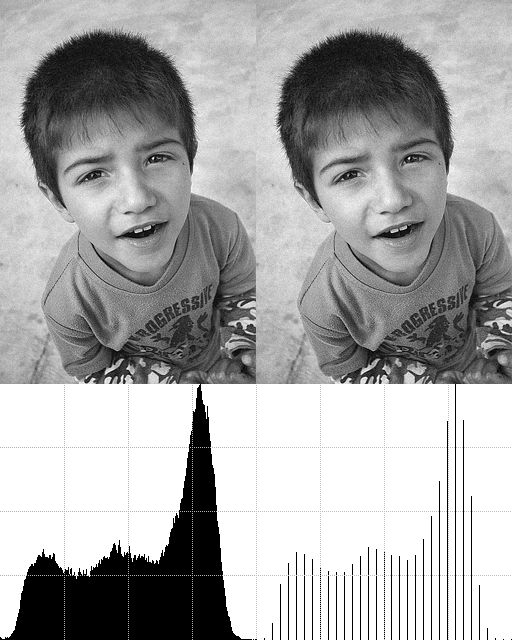
The only advantage of ETTR is reducing visible noise.
"Disadvantages:
■Requires more light than normal, potentially requiring a higher ISO speed
(which would offset any reduction in image noise)."
This is not correct, specially in Canon cameras. For a given exposure (aperture/shutter) pushing ISO can dramatically improve SNR. So ISO can be used for ETTR reducing visible noise, and that means ETTR is of application even without requiring more light.
These images were obtained in a Canon 350D at the same aperture/shutter:
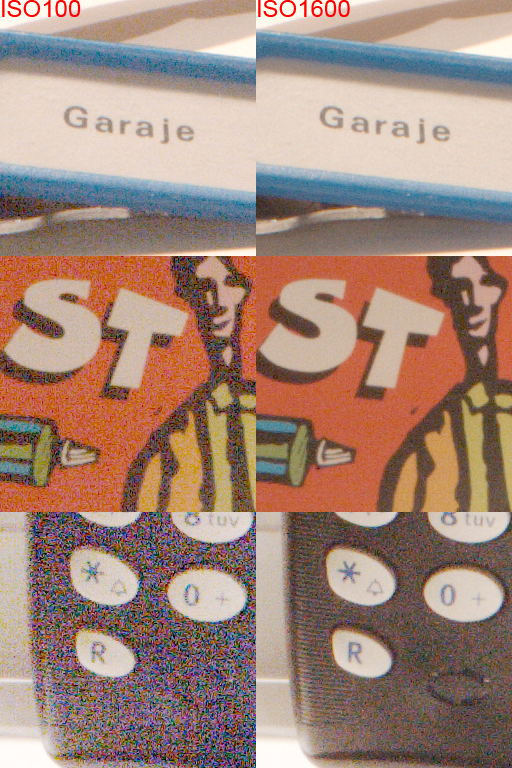
However in Nikon sensors, the noise improvement for pushing ISO is more reduced. And in the last Sony sensor appeared (Nikon D7000, Sony A380, Pentax K5), rising ISO has almost no effect in improving visible noise. They could be regarded as ISO-less cameras.
Canon sensors are clearly the ones that benefit more from rising ISO to get higher RAW exposure levels.
RegardsLast edited by _GUI_; 12th February 2011 at 09:45 PM.
-
12th February 2011, 08:05 PM #13

- Join Date
- Dec 2008
- Location
- New Zealand
- Posts
- 17,660
- Real Name
- Have a guess :)
-
12th February 2011, 09:28 PM #14

- Join Date
- May 2008
- Location
- Madrid (Spain)
- Posts
- 169
-
12th February 2011, 10:00 PM #15
Re: About the Tutorial: DIGITAL EXPOSURE TECHNIQUES
Hi Gui,
I am curious about the question of Posterization and read that limited dynamic range can be the cause of it.
I have a snap shot taken this morning when it was foggy and damp with the histogram clumped in the middle,these are the levels of the Red -73 - 172, Green - 83 - 164, Blue - 93 - 168, I wonder would these levels cause Posterization, or am I on the wrong track altogether.
Best Wishes Pat.
-
12th February 2011, 10:07 PM #16
Re: About the Tutorial: DIGITAL EXPOSURE TECHNIQUES
This is interesting. I don't have a Canon or a Sony to test with but DxOMark is readily available and easy to understand. Lets assume, for this argument, DxOMark is essentially 100% accurate.
According to your statement the Sony sensor graphs should have steeper slopes than Nikon graphs, and Nikon steeper than Canon. What I have observed between Nikon and Canon is that most of the graphs are parallel, and sometimes the the Nikons are steeper than the Canons, but never have I seen the opposite. This seems to be consistent with your statement.
I did not look at the Sony ones, but I would rather not because my observations are extremely subjective and depend on the fact that DxOMark is 100% accurate
-
12th February 2011, 11:22 PM #17

- Join Date
- May 2008
- Location
- Madrid (Spain)
- Posts
- 169
Re: About the Tutorial: DIGITAL EXPOSURE TECHNIQUES
It's not actually about how steep the SNR slopes are, but if they remain parallel and at which offset. SNR slopes parallel and 1EV offset at 1 stop ISO increments, provide no improvement in SNR through pushing ISO.
This is easily understood by looking at the graphs. I have reproduced the DxO Mark SNR curves for 3 cameras: Canon 5D2, Nikon D700 and Pentax K5. I used the SensorGen data, which comes from building a sensor noise model from DxO Mark plots based on read noise and full well capacity.
NOTE: X-axis = stops, Y-axis = dB (6dB = 1 stop)
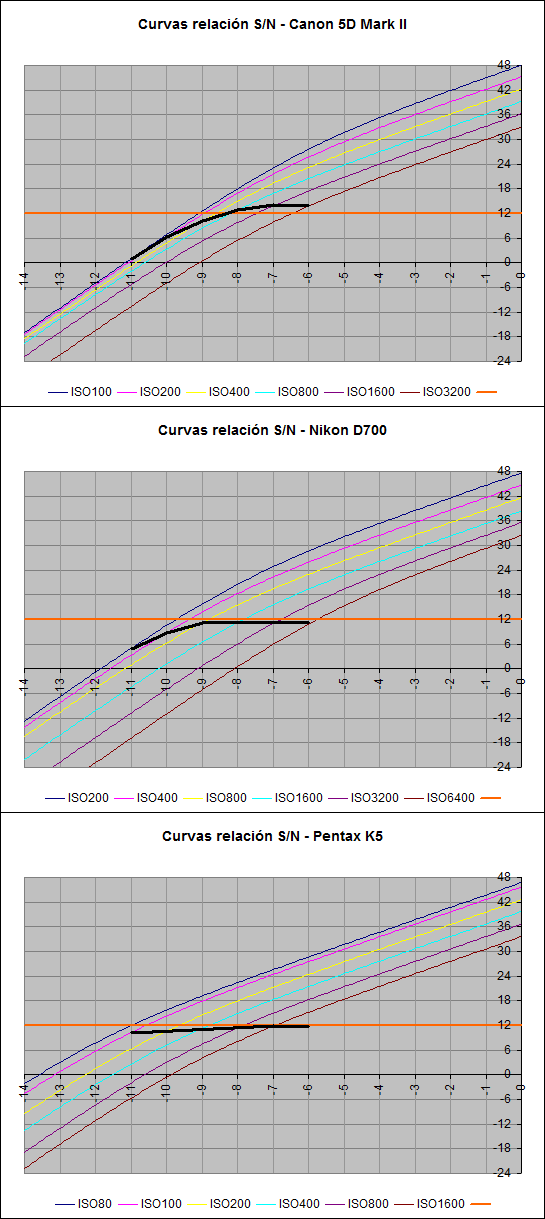
The thick black line represents the improvement in visible noise in the deep shadows when rising ISO in 5 stops:
- Canon 5D2: SNR improved by 2.1 stops. Improvement happened specially at low ISOs and till ISO1600
- Nikon D700: SNR improved by 1 stop. Improvement happened specially at low ISOs and till ISO800
- Pentax K5: SNR improved by 1/4 stop. Improvement happened progresively till ISO1600
- In the Canon, it's critical to abandon low ISOs if using them will mean low RAW exposure.
- In the Nikon, although it is recommended not to stick to low ISOs if we are not getting enough RAW exposure, pushing ISO is not so critical.
- In the Pentax, it is not worth to push ISO. If the scene contains highlights, we would sacrifice up to 5 stops of highlights information for just a 1/4 stop improvement in shadows noise.
RegardsLast edited by _GUI_; 13th February 2011 at 12:12 AM.
-
12th February 2011, 11:34 PM #18

- Join Date
- Dec 2008
- Location
- New Zealand
- Posts
- 17,660
- Real Name
- Have a guess :)
-
13th February 2011, 12:51 AM #19Administrator

- Join Date
- Apr 2008
- Location
- California, USA
- Posts
- 1,473
- Real Name
- Sean
Re: About the Tutorial: DIGITAL EXPOSURE TECHNIQUES
In every example I am referring to the resulting image (ie, what the photo would look like), not the data in an unprocessed RAW file. I think that's what most readers are concerned with. It's true that I could say "an image developed from RAW file" or "an image from a RAW" instead of "a RAW image," but we're really parsing words here. If it would help I can change that though.
Also, I agree with you that dithering can help the appearance of posterization, but to say that something isn't posterized because it has been dithered isn't necessarily true. Yes, smooth gradations will no longer have abrupt jumps when dithering is used, but this gradation is still being created from fewer colors (and will appear different/noisier). Furthermore, fine color detail cannot always be dithered without also sacrificing color resolution.
Perhaps it's an issue of definition differences, so let me clarify. From the image posterization tutorial, I use this to describe it:
"Posterization occurs when an image's apparent bit depth has been decreased so much that it has a visual impact. The term posterization is used because it can influence your photo similar to how the colors may look in a mass-produced poster, where the print process uses a limited number of color inks. This effect ranges from subtle to quite pronounced, although one's tolerance for posterization may vary."
Even here, the reduction in bit depth has a visible impact on the image, so I'd consider the image on the right to have become "posterized" -- but just barely. Look at the background: the 5-bit image has more noise. Yes, it's subtle -- in part because this is a best case example -- but it's there nonetheless. Try reducing the image on the right to 4-bit instead of 5-bit and the effect is really dramatic. Alternatively, posterization would have been more apparent with finer and subtler tonal detail.
Regardless, I'd also contend that this isn't a fair or representative example. First, you are applying posterization to a gamma-corrected image (in a perceptually uniform space). Posterization that would be caused by a grossly underexposed RAW file would happen on linear image data. This would be much more apparent -- particularly in the shadows. Second, you've applied posterization *after* all other image processing steps have been applied, including sharpening.
We've already discussed a lot of the details of this example here, so I'm not going to rehash all of that again.
First, I think you are interpreting my use of "offset" to mean "cancel," when what I'm intending is something along the lines of "mitigate." Second, I'm just saying that the benefit of ETTR wouldn't be as great if you also had to increase ISO speed, which is something I continue to stand by. Let's look at three example scenarios:
(A) Initial shot with standard exposure: f/4, ISO100 and 1/60 sec
(B) ETTR while maintaining hand-holdability: f/4, ISO400 and 1/60 sec
(C) ETTR without maintaining hand-holdability: f/4, ISO100 and 1/15 sec
I think we can all agree that the noise in (C) would be less than the noise in (B). That's what I'm referring to in my statement above. However, what I gather you're contending is that the noise in (B) is less than the noise in (A), which is a whole other topic entirely (see below). I don't think your B to A comparison is at all relevant to my statement, because you're in effect saying that ETTR reduces image noise, which has already been established.
In general, I completely agree that it's better to increase the ISO speed during the shot than to do this digitally during RAW post-processing (which is what your example is illustrating). I think that's an important point and am glad you are sharing actual examples. But as you say, the effects of this are highly variable from camera to camera (and even from ISO to ISO). The results all depend on which ISO speeds are achieved by effectively increasing the analog gain, or are achieved by sacrificing tonal levels in digital processing.
Please understand that I likely won't have time to go back and forth on this topic at length, so I hope my above explanation suffices.Last edited by McQ; 13th February 2011 at 01:24 AM.
-
13th February 2011, 01:47 AM #20

- Join Date
- May 2008
- Location
- Madrid (Spain)
- Posts
- 169
Re: About the Tutorial: DIGITAL EXPOSURE TECHNIQUES
Me too. Noise in the RAW file dithers any possible source of posterization that could affect the final image. So in practice ETTR has no impact in preventing posterization in the resulting image, it just improves SNR. If posterization appears in the final image, it's our fault in pp, and ETTR in the capture wouldn't have helped us to prevent it.
In that image, the added noise has a visible impact on the image, not the reduction of bitdepth. Just as RAW noise has an impact in the final image, not the lack of bitdepth (bits on the ADC) which is adequately chosen by camera manufacturers so that it never becomes the limiting factor.
It's again the same question: posterization affects more the deep shadows in a linear image, but RAW noise is also added on the linear image. As long as noise is fairly greater than one bit interval (and this is guaranteed by the bitdepth of the ADC chosen), posterization on the RAW file is simply impossible because noise takes care of it. Posterized RAW files don't exist, and posterized resulting images because of a lack of levels due to not performing ETTR don't exist either. Posterization is always a matter of pp, regardless if ETTR was used or not.
Look at these examples from the deepest shadows displaying detail on a Canon 40D at ISO100:
RAW development at 14 bits:
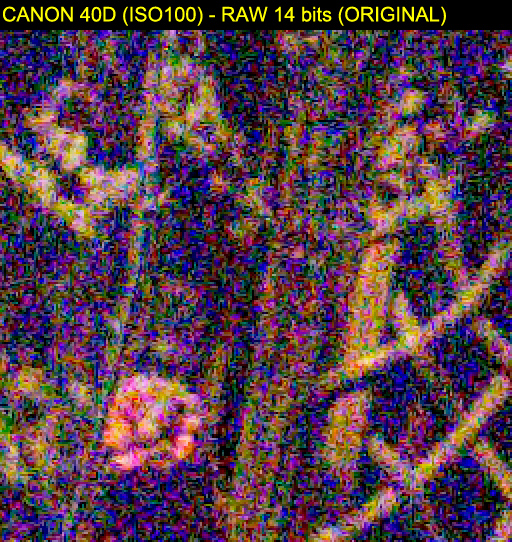
RAW development at 12 bits:
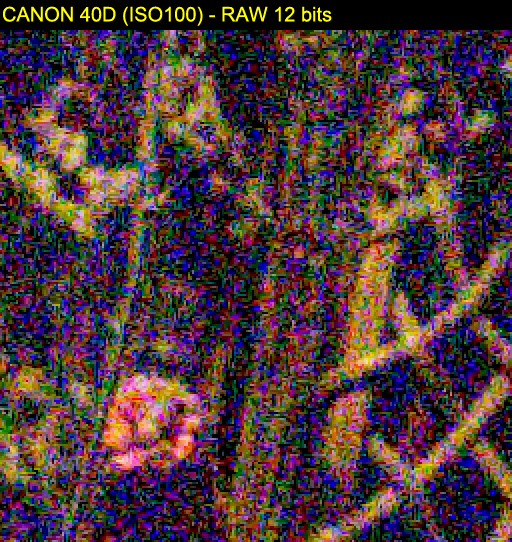
The second image just has some noisy pixels clipped to zero, but it displays no posterization nor any loss of detail. So in practice that camera doesn't need/deserve/benefit from its 14-bit ADC because noise was still much greater than one bit interval in the 12-bit scale.
For this camera 14-bit RAW files are just a marketing decision and a 12-bit ADC producing smaller RAW files would have sufficed.
On the other hand, for the Pentax K5 the 14-bits are indeed useful. Due to its ultra low noise in the deep shadows, the K5 would display RAW posterization if its RAW files were encoded in just 12 bits, and this would affect the resulting image:
RAW development at 14 bits:
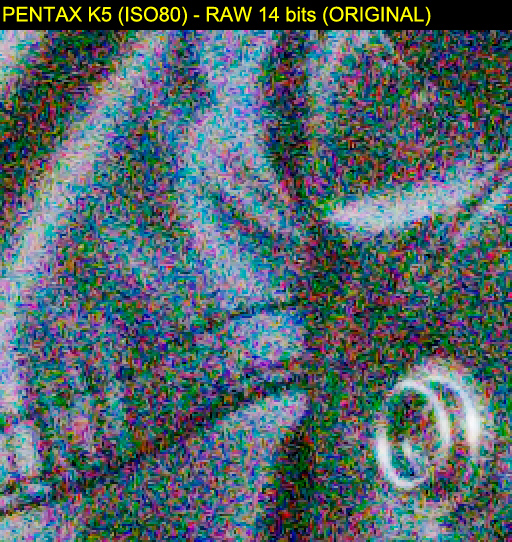
RAW development at 12 bits:
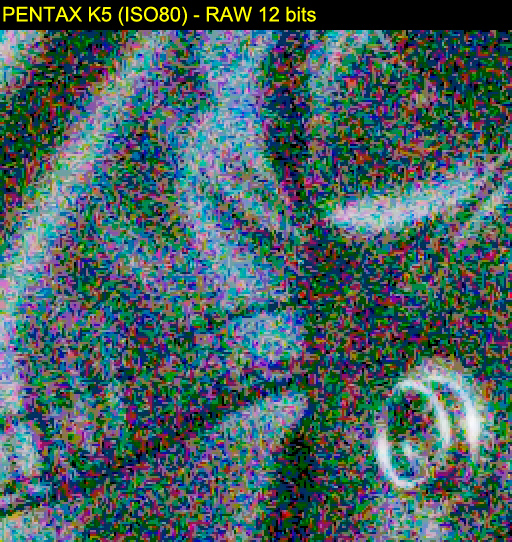
Agreed then. ETTR through ISO is not so optimum as ETTR through aperture or shutter.
RegardsLast edited by _GUI_; 13th February 2011 at 01:50 PM.


 Reply With Quote
Reply With Quote
